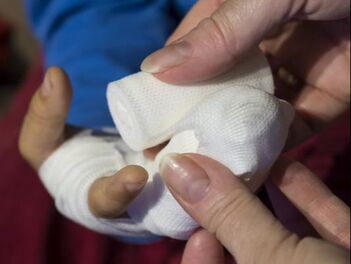|
Small, superficial lacerations (cuts) simply should be cleaned with plenty of soap and water. Apply direct pressure for 10 minutes to stop any bleeding. Apply an over-the-counter antibiotic ointment and cover it with a bandaid or gauze. Wash the wound, apply the ointment, and change the bandaid daily. Do not kiss the wound or use alcohol on the wound. Let the scab fall off by itself. If suturing the wound is necessary, it must be done as soon as possible after the skin is cut. After 4 hours for bite wounds and 18 hours for other wounds, suturing is no longer an option due to risk of infection. If the laceration is deep and the edges are more than one millimeter apart, then the wound should probably be sutured. A deep laceration is more likely to scar if it is not sutured. If you can bring the edges together and keep them together with a “butterfly” bandaid, then suturing may not be necessary. Depending on their location and depth, some lacerations can be repaired at our office using a special “glue” called Dermabond.
Additionally, be sure to check the date of your child’s last tetanus shot. If Dtap [DO NOT USE ABBREVIATIONS] or Td [DO NOT USE ABBREVIATIONS] have not been given within 5 years of the injury, your child might need a booster. Call our office immediately if:
Comments
|
AuthorThe staff of Panda Pediatrics, located in Washington, D.C. Categories
All
Archives |
|
Schedule your visit today!
|
HOURSMon: 9am-5pm
Tues: 9am-5pm Wed: 9am-5pm Thurs: 9am-5pm Fri: 9am-2pm Closed daily 12pm-1pm. |
Phone: 202-466-5350
Fax: 202-466-8555 After Hours: 703-535-1856 Email: info@pandaped.com Billing: 1-888-969-3735, option# 1 |
ADDRESS2440 M Street NW
Suite #422 Washington, DC 20037 POLICIES |

 RSS Feed
RSS Feed

